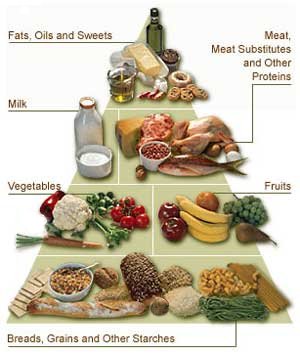
Using the Diabetes Food Pyramid
The Diabetes Food Pyramid divides food into six groups. These groups or sections on the pyramid vary in size. The largest group -- grains, beans, and starchy vegetables -- is on the bottom. This means that you should eat more servings of grains, beans, and starchy vegetables than of any of the other foods. The smallest group -- fats, sweets, and alcohol -- is at the top of the pyramid. This tells you to eat very few servings from these food groups.
The Diabetes Pyramid gives a range of servings. If you follow the minimum number of servings in each group, you would eat about 1600 calories and if you eat at the upper end of the range, it would be about 2800 calories. Most women, would eat at the lower end of the range and many men would eat in the middle to high end of the range if they are very active. The exact number of servings you need depends on your diabetes goals, calorie and nutrition needs, your lifestyle, and the foods you like to eat. Divide the number of servings you should eat among the meals and snacks you eat each day.
The Diabetes Food Pyramid is a little different than the USDA Food Guide Pyramid because it groups foods based on their carbohydrate and protein content instead of their classification as a food. To have about the same carbohydrate content in each serving, the portion sizes are a little different too. For example: you will find potatoes and other starchy vegetables in the grains, beans and starchy vegetables group instead of the vegetables group. Cheese is in the meat group instead of the milk group. A serving of pasta or rice is 1/3 cup in the Diabetes Food Pyramid and ½ cup in the USDA pyramid. Fruit juice is ½ cup in the Diabetes Food Pyramid and ¾ cup in the USDA pyramid. This difference is to make the carbohydrate about the same in all the servings listed.
Following is a description of each group and the recommended range of servings of each group.
Grains and Starches
At the base of the pyramid are bread, cereal, rice, and pasta. These foods contain mostly carbohydrates. The foods in this group are made mostly of grains, such as wheat, rye, and oats. Starchy vegetables like potatoes, peas, and corn also belong to this group, along with dry beans such as black eyed peas and pinto beans. Starchy vegetables and beans are in this group because they have about as much carbohydrate in one serving as a slice of bread. So, you should count them as carbohydrates for your meal plan.
Choose 6-11 servings per day. Remember, not many people would eat the maximum number of servings. Most people are toward the lower end of the range.
Serving sizes are:
1 slice of bread
¼ of a bagel (1 ounce)
½ an English muffin or pita bread1,
6 inch tortilla
¾ cup dry cereal½ cup cooked cereal½ cup potato, yam, peas, corn, or cooked beans
1 cup winter squash1/3 cup of rice or pasta
Vegetables
All vegetables are naturally low in fat and good choices to include often in your meals or have them as a low calorie snack. Vegetables are full of vitamins, minerals and fiber. This group includes spinach, chicory, sorrel, Swiss chard, broccoli, cabbage, bok choy, brussels sprouts, cauliflower, and kale, carrots, tomatoes, cucumbers, and lettuce. Starchy vegetables such as potatoes, corn, peas, and lima beans are counted in the starch and grain group for diabetes meal planning.
Choose at least 3-5 servings per day.
A serving is:
1 cup raw½ cup cooked
Fruit
The next layer of the pyramid is fruits, which also contain carbohydrates. They have plenty of vitamins, minerals, and fiber. This group includes blackberries, cantaloupe, strawberries, oranges, apples, bananas, peaches, pears, apricots, and grapes.
Choose 2-4 servings per day
A serving is:
½ cup canned fruit
1 small fresh fruit
2 tbs dried fruit
1 cup of melon or raspberries
1 ¼ cup of whole strawberries
Milk
Milk products contain a lot of protein and calcium as well as many other vitamins. Choose non-fat or low-fat dairy products for the great taste and nutrition without the saturated fat.
Choose 2-3 servings per day
A serving is:
1 cup non-fat or low-fat milk
1 cup of yogurt
Meat and Meat Substitutes
The meat group includes beef, chicken, turkey, fish, eggs, tofu, dried beans, cheese, cottage cheese and peanut butter. Meat and meat substitutes are great sources of protein and many vitamins and minerals.
Choose from lean meats, poultry and fish and cut all the visible fat off meat. Keep your portion sizes small. Three ounces is about the size of a deck of cards. You only need 4-6 ounces for the whole day.
Choose 4-6 oz per day divided between meals
Equal to 1 oz of meat:
¼ cup cottage cheese
1 egg
1 Tbsp peanut butter
½ cup tofu
Fats, Sweets, and Alcohol
Things like potato chips, candy, cookies, cakes, crackers, and fried foods contain a lot of fat or sugar. They aren't as nutritious as vegetables or grains. Keep your servings small and save them for a special treat!
Serving sizes include:
½ cup ice cream
1 small cupcake or muffin
2 small cookies
The Diabetes Food Pyramid makes it easier to remember what to eat. For a healthy meal plan that is based on your individual needs, you should work with a registered dietitian (RD) with expertise in diabetes management.
By Flourish Wellness
http://www.flourishdiabetes.com/understanding.asp
